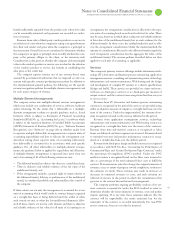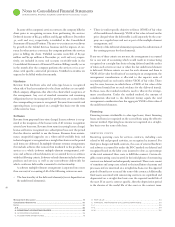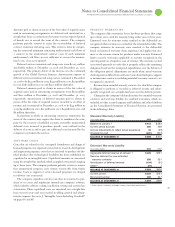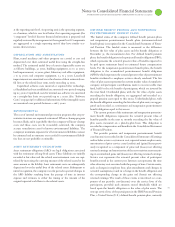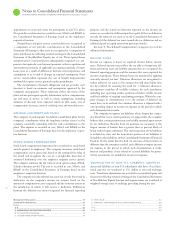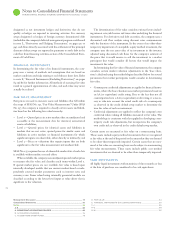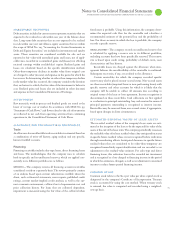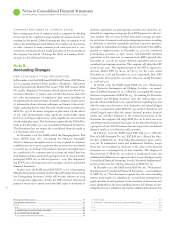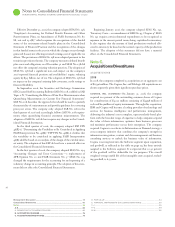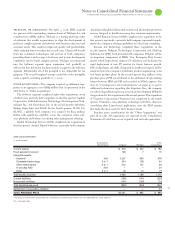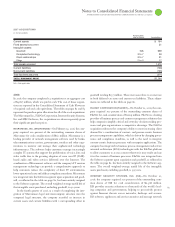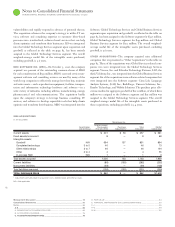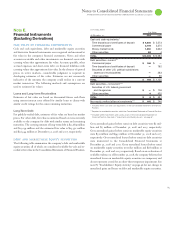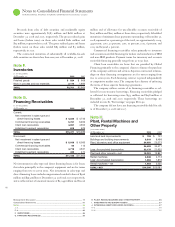IBM 2008 Annual Report Download - page 78
Download and view the complete annual report
Please find page 78 of the 2008 IBM annual report below. You can navigate through the pages in the report by either clicking on the pages listed below, or by using the keyword search tool below to find specific information within the annual report.
Notes to Consolidated Financial Statements
INTERNATIONAL BUSINESS MACHINES CORPORATION and Subsidiary Companies
Management Discussion ............................................................................................. 18
Consolidated Statements ............................................................................................ 60
Notes ............................................................................................................................... 66
A – E ........................................................................................................................66
A. SIGNIFICANT ACCOUNTING POLICIES ..........................................................66
B. ACCOUNTING CHANGES ................................................................................76
C. ACQUISITIONS/DIVESTITURES ........................................................................78
D. FAIR VALUE ......................................................................................................84
E. FINANCIAL INSTRUMENTS (EXCLUDING DERIVATIVES) .................................85
F – J ........................................................................................................................86
K– Q .......................................................................................................................88
R –W ..................................................................................................................... 10 2
Basic earnings per share of common stock is computed by dividing
net income by the weighted-average number of common shares out-
standing for the period. Diluted earnings per share of common stock
reflects the maximum potential dilution that could occur if securities
or other contracts to issue common stock were exercised or con-
verted into common stock and would then share in the net income of
the company. See note R, “Earnings Per Share of Common Stock,”
on page for additional information.
Note B.
Accounting Changes
In December , the FASB issued FASB Staff Position (FSP) Finan-
cial Accounting Standard (FAS) (R)- “Employers’ Disclosures
about Postretirement Benefit Plan Assets”. This FSP amends SFAS
No. (R), “Employers’ Disclosures about Pensions and Other Post-
retirement Benefits” to require more detailed disclosures about the
fair value measurements of employers’ plan assets including (a)
investment policies and strategies; (b) major categories of plan assets;
(c) information about valuation techniques and inputs to those tech-
niques, including the fair value hierarchy classifications (as defined by
SFAS No. ) of the major categories of plan assets; (d) the effects
of fair value measurements using significant unobservable inputs
(Level ) on changes in plan assets; and (e) significant concentrations
of risk within plan assets. The disclosures required by the FSP will be
made in the December , Consolidated Financial Statements.
This Statement does not impact the consolidated financial results as
it is disclosure-only in nature.
In November , the FASB ratified the Emerging Issues Task
Force (EITF) Issue -, “Accounting for Defensive Intangible
Assets”. A defensive intangible asset is an asset acquired in a business
combination or in an asset acquisition that an entity does not intend
to actively use. According to the guidance, defensive intangible assets
are considered to be a separate unit of account and valued based on
their highest and best use from the perspective of an external market
participant. EITF - is effective January , . The adoption of
this EITF issue is not expected to have an impact on the Consolidated
Financial Statements.
In June , the FASB issued FSP EITF --, “Determining
Whether Instruments Granted in Share-Based Payment Transactions
Are Participating Securities,” which will become effective in
via retrospective application. Under the FSP, unvested share-based
payment awards that contain non-forfeitable rights to dividends or
dividend equivalents are participating securities and, therefore, are
included in computing earnings per share (EPS) pursuant to the two-
class method. The two-class method determines earnings per share
for each class of common stock and participating securities according
to dividends or dividend equivalents and their respective participa-
tion rights in undistributed earnings. Restricted Stock Units (RSUs)
granted to employees prior to December , are considered
participating securities as they receive non-forfeitable dividend
equivalents at the same rate as common stock. RSUs granted after
December , do not receive dividend equivalents and are not
considered participating securities. The company will adopt the FSP
in fiscal year . The implementation of the FSP is expected to
decrease diluted EPS by $. and $. for the years ended
December , and December , , respectively. Basic EPS
is expected to decrease by $. in each of the years ended December
, and .
In March , the FASB issued SFAS No. , “Disclosures
about Derivative Instruments and Hedging Activities — an amend-
ment of FASB Statement No. .” SFAS No. expands the current
disclosure requirements of SFAS No. , “Accounting for Derivative
Instruments and Hedging Activities,” such that entities must now
provide enhanced disclosures on a quarterly basis regarding how and
why the entity uses derivatives; how derivatives and related hedged
items are accounted for under SFAS No. and how derivatives and
related hedged items affect the entity’s financial position, financial
results and cash flow. Pursuant to the transition provisions of the
Statement, the company will adopt SFAS No. in fiscal year
and will present the required disclosures in the prescribed format on
a prospective basis. This Statement does not impact the consolidated
financial results as it is disclosure-only in nature.
In February , the FASB issued FSP FAS -, “Effective
Date of FASB Statement No. .” FSP FAS - delayed the effec-
tive date of SFAS No. “Fair Value Measurements” from to
for all nonfinancial assets and nonfinancial liabilities, except
those that are recognized or disclosed at fair value in the financial
statements on a recurring basis (at least annually). The adoption of
the provisions of SFAS No. related to nonfinancial assets and
nonfinancial liabilities is not expected to have a material impact on the
Consolidated Financial Statements. See the “Standards Implemented”
section of this note for a further discussion of SFAS No. .
In December , the FASB issued SFAS No. , “Noncontrol-
ling Interests in Consolidated Financial Statements — an amendment
of ARB No. .” This Statement requires that the noncontrolling
interest in the equity of a subsidiary be accounted for and reported as
equity, provides revised guidance on the treatment of net income and
losses attributable to the noncontrolling interest and changes in own-
ership interests in a subsidiary and requires additional disclosures that



